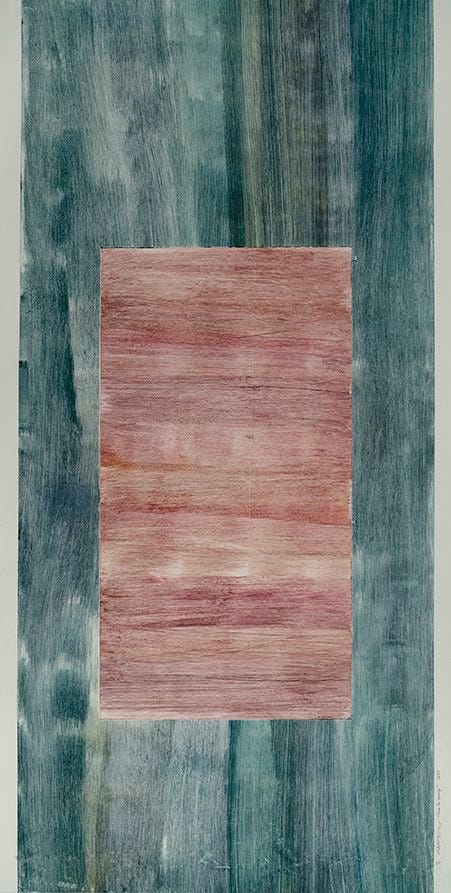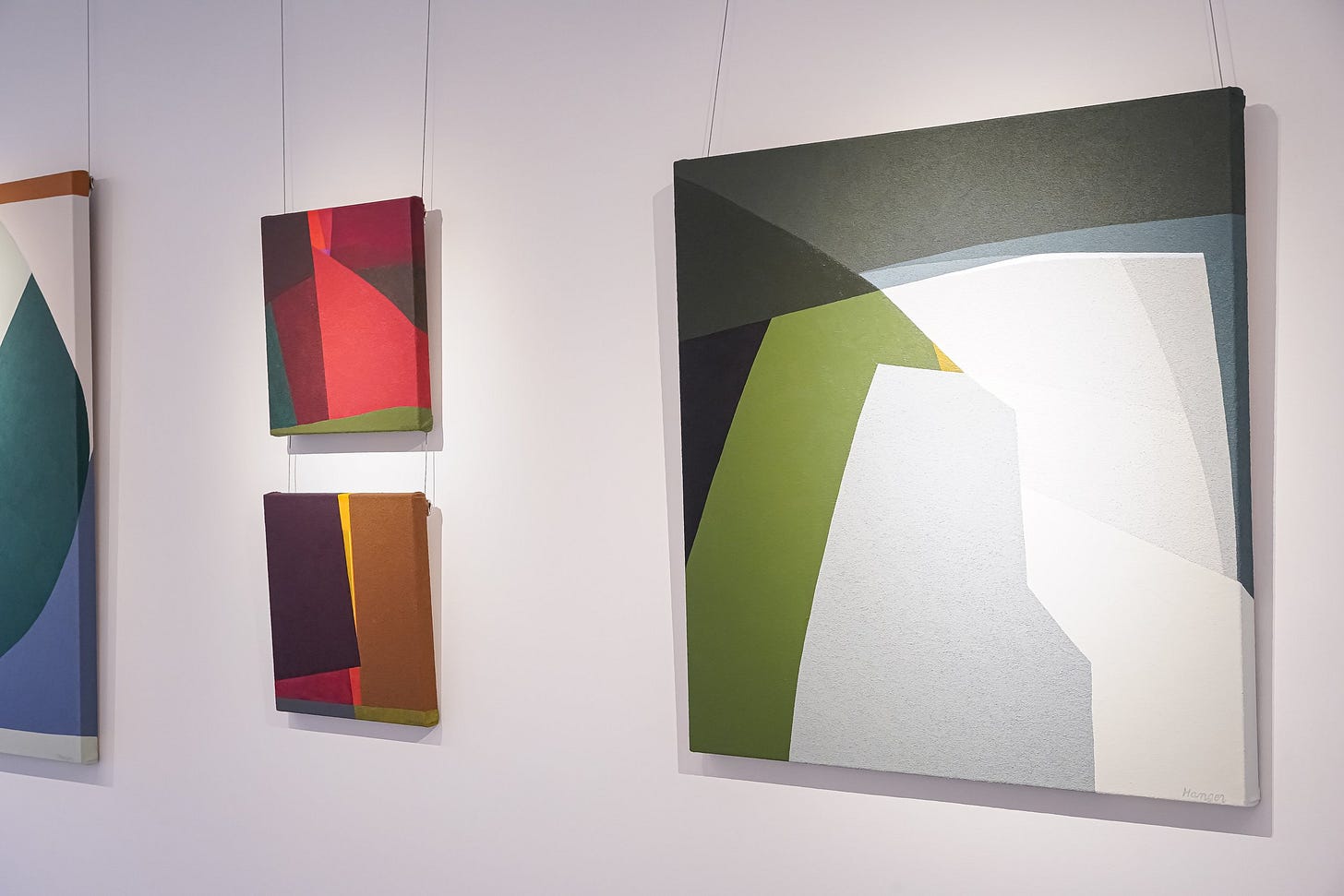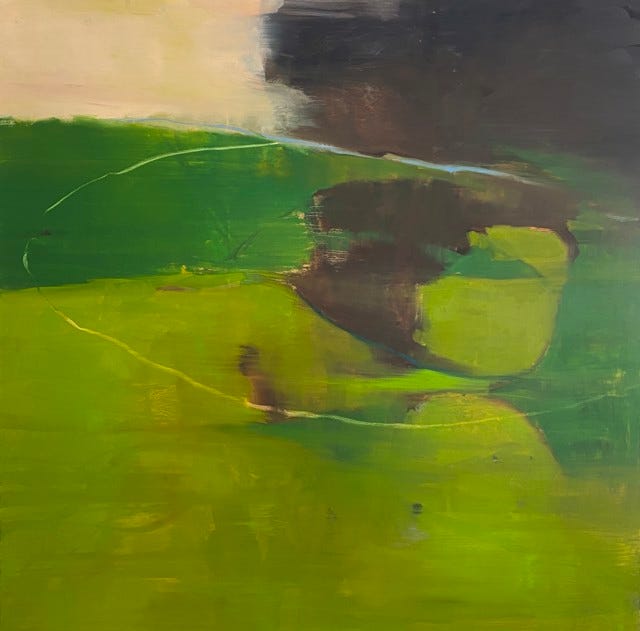Scratches and Splashes
Kristine DeNinno's prints and Anne Hanger and Jane Kell's paintings are almost abstract, but infused with meaning
Kristine DeNinno, “Time for a Change 1” (Washington Printmakers Gallery)
COLOR AND TEXTURE ARE CENTRAL TO THE PICTURES made by Kristine DeNinno, Anne Hanger, and Jane Kell, yet all three are representational artists, of a sort. Hanger and Kell paint landscapes, however untraditionally. Even more symbolic are DeNinno's prints, which the D.C.-area artist's statement describes as "visually abstract narratives" that represent "the fluidity and individuality of women's lives."
DeNinno's works are on paper, but the monoprints and linocuts in "Women's Work" evoke fabric and often include minimalist stitchery. The most striking pieces in the Washington Printmakers Gallery show are vertical hanging scrolls, three of which were printed with two plates. In these, a red rectangle floats on a green-blue field, and both parts appear intricately scraped, albeit in contrasting directions. These elegant prints are in the tradition of color field paintings, but the handsomely worn hues are anything but exuberant. The red resembles long-dried blood, and green is cool and drained of brightness.
Some of the banners include simple thread-work whose direction follows that of the inked striations. Also included is a series of mostly single-color square linocuts -- each titled "Stitch & B*tch" plus its color -- composed of reversed-white gashes that emanate from a pair of interlocked central triangles. Each print is sewn with thread of a hue that matches the backdrop. Visually, the contrast is subtle and mostly textural. Thematically, the dashed thread lines represent millennia of domestic labor.
A few banners are multi-colored, although still muted, and more painterly. They look more brushed than scratched, with strokes of brown and purple infused into the predominant green. Four of the vertical pictures are titled with women's names (including "Kamala"), while others invoke eons of frustration. "Time for a Change 1" may be a call for revolution, but its weathered hues speak more to endurance than transformation.
Installation view of Anna Hanger’s “Wanderings” (Latela Curatorial)
ANNE HANGER'S STUDIO IS NEAR VIRGINIA'S BLUE RIDGE MOUNTAINS, and her nearly abstract paintings are inspired by sunrises framed by the peaks. So says the statement from Latela Curatorial, which programmed the artist's "Wanderings" for the Adams-Morgan lobby space called the Silva Gallery. Of the eight small and six large pictures, however, only "Plateau" strongly suggests a rural landscape. That some of the paintings might be informed by metropolitan locales is underscored by one title, "Urban Light."
The artist mixes acrylic paint with sand to endow a tactile quality to the hard-edged blocks of color, generally bright but occasionally neutral. The role of the white, tan, or gray sectors is usually to set off robust hues, most often green or red. But Hanger flips that strategy in "Urban Light," in which two dominant sections in different shades of gray are framed by bands of green or light blue. The gray paint's nubby surface hints at sidewalks or the walls of Brutalist structures, and the mere glimmers of green and blue can be seen as nature pushed to the margins of cityscapes.
Most of the forms are more geometric than naturalistic. The two partial orbs in "Night Watch," both cunningly distinguished from surroundings that are almost identically hued, are rare examples of curved shapes. More usual as slabs of color, sometimes pushing against each other like tectonic plates. Hanger considers her pictures "conducive to silence and reflection." Yet there's an intriguing sense of tension generated by the thrusting shapes and juxtaposed colors. Rather than think of sunrises over ridges, viewers may imagine the slow but potent forces that pushed those mountains toward the sky.
Jane Kell, “Shallows” (Amy Kaslow Gallery)
THERE'S NOTHING URBAN ABOUT THE PAINTINGS IN JANE KELL'S "Skyline," which depict rustic vistas whose heavens are just as likely to be red as blue. The British oil painter -- a former artist in residence at Amy Kaslow Gallery, which hosts her current show -- has a liquid, luminous style that evokes both clouds and sunlight. Kell begins with diluted pigments, which she then overlays with thicker paint. Regions of thinner color sometimes survive, providing radiant highlights.
Most of these 12 canvases depict eventful skies above land masses rendered simply as jagged black horizontals. At the bottom of a few pictures are expanses of water, whose blues either mirror or contrast the colors above. In "Harbour," a bit of reflected red-orange sky splashes into medium-blue water. The grayish sky of "River in Winter IV" has a faintly golden glow, but the brightest hue is the orange foliage that lines the ice-blue waterway.
The most abstract pictures forgo horizon lines and earthbound details to lead the eye directly into rich hues and active brushwork. Two of these paintings are mostly loose stacks of sumptuous blues, with rough swathes of gray or white to hint at clouds or sunlight. The predominantly green "Shallows" employs a similar strategy, but in this case the enveloping hue could be a pond, perhaps punctuated by lily pads or other aquatic vegetation. Again, the fluidity of these paintings suits their subjects, whether airy or liquid. Kell's work is a plunge into color.
Kristine DeNinno: Women's Work
Through Feb. 23 at Washington Printmakers Gallery, 1675 Wisconsin Ave NW. washingtonprintmakers.com. 202-669-1497.
Anne Hanger: Wanderings
Through Feb. 16 at the Silva Gallery x Latela Curatorial, 1630 Columbia Rd. NW. latelacuratorial.com.
Jane Kell: Skyline
Through Feb. 16 at Amy Kaslow Gallery, 7920 Norfolk Ave., Bethesda. amykaslowgallery.com.



